The end of the world has fascinated humans for centuries, and predictions vary widely. Many religious texts warn of signs like wars, disasters, and moral decay. Scientifically, theories range from heat death to cosmic collapse. Current global challenges, such as climate change, social instability, and biodiversity loss, also suggest a precarious future. Upcoming astronomical events add to the intrigue, while prophecies from mystics add a layer of mystery. You're invited to explore these diverse perspectives and insights that shape our understanding of the world's fate and what it means for you.
Essential Insights
- Various religious beliefs predict the end of the world through events like wars, natural disasters, and moral decay, culminating in a final judgment.
- Scientific theories propose cosmic endings such as Heat Death, Cosmic Collapse, and the Big Rip, each presenting different scenarios for the universe's fate.
- Climate change poses significant risks, with extreme weather events and biodiversity loss potentially leading to ecological tipping points that threaten future generations.
- Ongoing social conflicts, displacement crises, and food insecurity exacerbate global instability, making the prospect of societal collapse more imminent.
- Upcoming astronomical events, like eclipses and asteroid close encounters, captivate interest but do not indicate an imminent end to the world.
Religious Predictions of the End
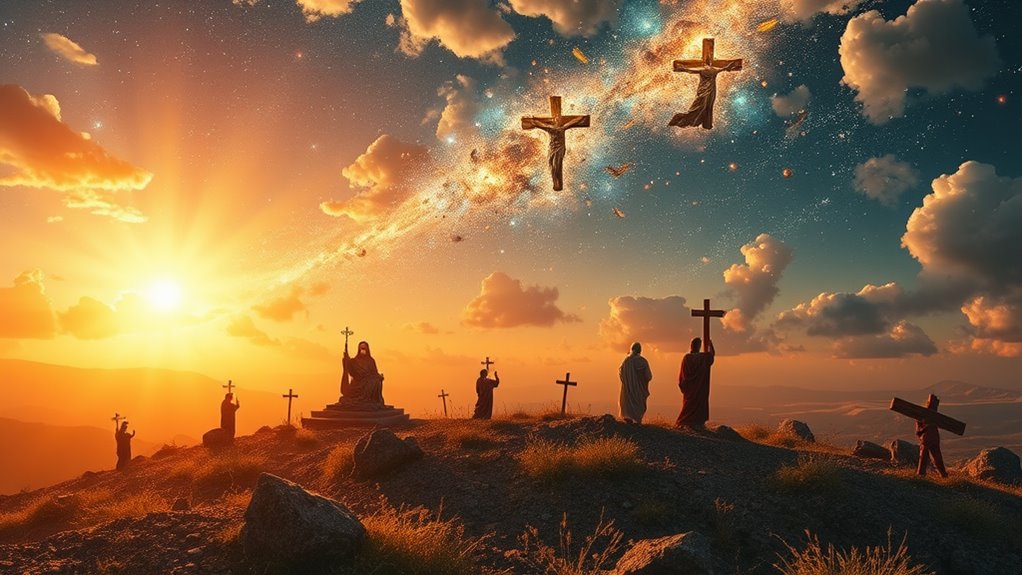
Throughout history, various religions have presented their own predictions about the end of the world, each offering unique insights into humanity's ultimate fate. These predictions often incorporate apocalyptic symbolism and prophetic timelines that evoke fear and fascination.
In Christianity, you might encounter warnings of war and conflict, where nations rise against each other, along with famine, disease, and catastrophic natural events. Great earthquakes and pestilences paint a grim picture of suffering and loss. The environmental degradation humanity faces today echoes these prophecies, emphasizing the consequences of our violent and corrupt actions. Additionally, many Christians believe that these signs of the last days are evident in the increasing lawlessness and societal breakdown, as foretold in the Bible.
Buddhism predicts a fiery apocalypse around the year 4600, with six suns heralding the world's end. The Hindu concept of Kali Yuga describes a time of moral decay and social strife, culminating in the arrival of the Kalki Avatar, who'll vanquish evil.
Jewish and Zoroastrian traditions focus on judgment and resurrection, where souls face their deeds, and the righteous are restored to a pure earth after a final battle against evil.
In Islam, significant events like the conquest of Constantinople and the appearances of the Mahdi and the Dajjal signal an imminent end. The Second Coming of Jesus and the chaos caused by Gog and Magog contribute to this intricate tapestry of predictions.
These diverse religious perspectives enrich the conversation about humanity's fate, each framing our end in ways that resonate with believers across the globe.
Mystical Insights From Baba Vanga
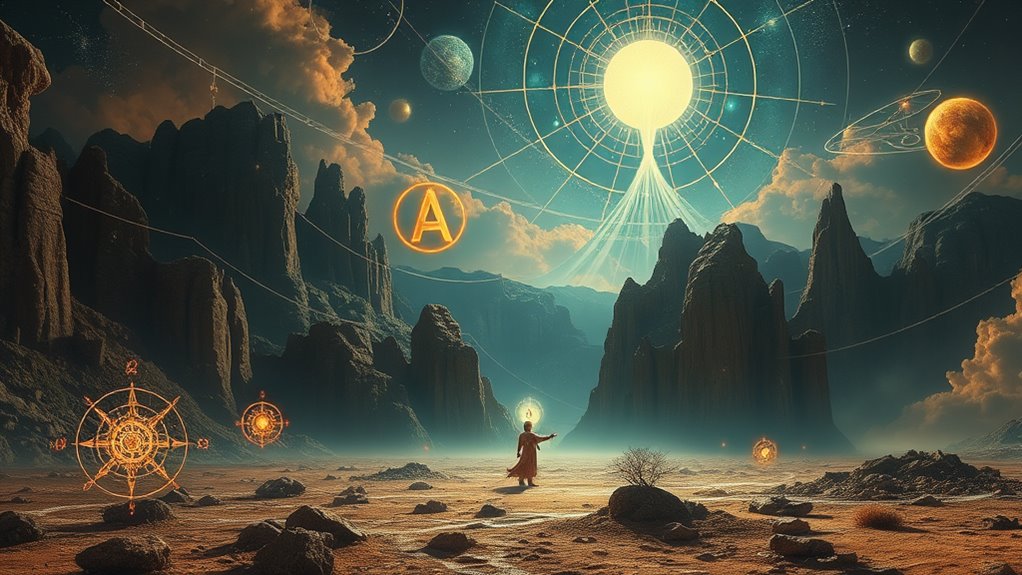
As we look to the future, the predictions of Baba Vanga, a Bulgarian mystic, offer a compelling glimpse into potential global upheavals. Her mystical foresight reveals a series of alarming events starting in 2025, which may alter the course of humanity. Among these, a devastating conflict in Europe is set to unfold, greatly impacting the continent's population. Intriguingly, she also foretold encounters with extra-terrestrial beings during a prominent global event that year. Notably, Baba Vanga's predictions have earned her the title of the "Nostradamus of the Balkans," reflecting her significant influence on prophetic traditions.
Here's a summary of Baba Vanga's most notable predictions:
| Year | Prediction |
|---|---|
| 2025 | Major conflict in Europe |
| 2028 | Exploration of Venus for energy |
| 2043 | Europe under Muslim rule |
| 5079 | The ultimate end of the world |
Baba Vanga's predictions don't stop there. By 2033, she suggests the polar ice caps will melt, leading to severe climate crises and natural disasters. These events are expected to disrupt social and political structures globally. In addition, she hints at a potential return of communist rule by 2076 and even a "Martian war" with alien beings.
The implications of these predictions resonate deeply, as they suggest a future filled with conflict and transformation. While some may dismiss her foresight, it prompts you to contemplate the unpredictable nature of our world's trajectory. What lies ahead remains uncertain, but Baba Vanga's insights certainly give you food for thought.
Christian Views on End Times

Baba Vanga's predictions spark curiosity about how various belief systems interpret the end of the world. In Christianity, the concept of the end times revolves around several key events. The Second Coming of Christ, or the Parousia, is central to Rapture Theology, where believers anticipate being taken up to meet Jesus. This event occurs after a period known as the Tribulation, marked by suffering and the rise of the Antichrist, whose identity sparks much debate.
The Millennialism debate focuses on whether Jesus will reign literally for a thousand years or if this reign is metaphorical. This debate is influenced by interpretations of the Millennium which vary between preterists, who see it as ongoing since Christ's ascension, and futurists anticipating a future fulfillment. Many Christians believe that the resurrection of the dead will happen, leading to the Last Judgment, where all souls face divine assessment. This judgment results in the ultimate creation of a New Heaven and New Earth, fulfilling God's promises.
Israel's role in these events is hotly contested—some argue that God still has a plan for Israel, while others believe the Church has replaced it. As you explore these themes, consider the End Times signs that Scripture warns about: natural disasters, wars, and societal upheaval all serve as indicators of what's to come.
Ultimately, Christian eschatology holds that following the Last Judgment, the faithful will enjoy eternal life, while others face eternal punishment. The expectations surrounding these events shape how you view current happenings in the world and their potential connection to biblical prophecy.
Islamic Perspectives on the Apocalypse

Islam's perspectives on the apocalypse offer a rich tapestry of beliefs rooted in the Quran and Sunnah, highlighting a unique eschatological framework. At the heart of Islamic eschatology are significant figures and events that shape the narrative of the end times. The Mahdi's significance is paramount, as he is believed to guide the faithful against the Dajjal's emergence, the Antichrist who spreads chaos and deception.
You'll encounter various apocalyptic signs, such as moral decay, natural disasters, and wars, all signaling the approach of the end times. The concept of Barzakh illustrates the intermediate state between life and the hereafter, where souls await resurrection. Additionally, the belief in Qiyamah emphasizes the certainty of divine justice and the importance of righteous living in preparation for the final day.
Here's a quick glance at key elements of Islamic apocalyptic beliefs:
| Key Figure/Event | Role in Apocalypse | Associated Concepts |
|---|---|---|
| Mahdi | Guides believers against injustice | Divine justice, end times events |
| Dajjal | Brings chaos before the final days | Moral decay, apocalyptic signs |
| Resurrection | All will be judged on Judgement Day | Barzakh concept, afterlife options |
As the universe faces destruction, the belief in resurrection fuels the understanding of divine justice. On Judgement Day, every individual will be accountable for their deeds, determining their eternal fate in Paradise or Hell. Through these beliefs, Islam prepares its followers for the profound realities of the end times.
Scientific Theories of Cosmic Endings
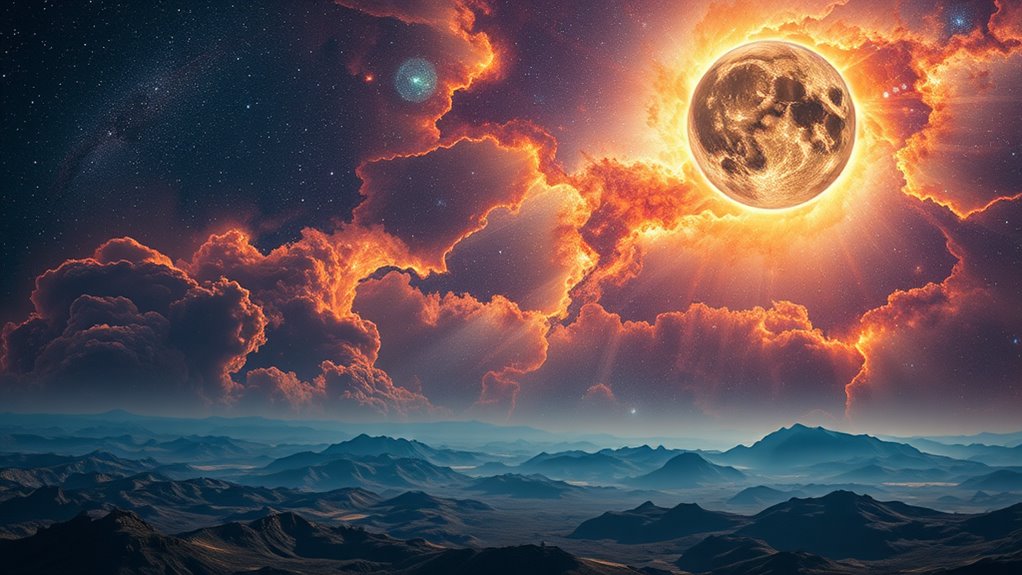
The universe's fate has long fascinated scientists, leading to various theories about how it might ultimately end. One of the most intriguing concepts is the Big Rip, fueled by dark energy. This mysterious force accelerates the universe's expansion, overpowering gravitational forces. Eventually, galaxies, stars, and even subatomic particles could be torn apart, leaving a void of non-interacting particles. As the universe expands, the probability of a global catastrophe remains extremely low, offering some comfort amid these cosmic theories.
Another scenario is the Heat Death of the universe. As the cosmos continues to expand, matter and energy will thin out, leading to a state of maximum entropy. In this chilling future, all energy will be uniformly dispersed, halting star formation and extinguishing existing stars. The universe will cool down to absolute zero, transforming into a barren, dark void.
Then there's the Cosmic Collapse, often referred to as the Big Crunch. Here, the universe's expansion would reverse due to gravitational attraction, causing everything to collapse into a singularity. Imagine galactic and stellar collisions occurring more frequently as densities and temperatures skyrocket until the universe blinks out of existence.
Lastly, consider the Holographic Universe theory. It posits that our reality might be a quantum illusion. In the Long Freeze, the universe would halt its expansion, taking on a finite shape before entering a state of cascading entropy.
Each of these theories presents a different vision of cosmic endings, showcasing the complexity and mystery surrounding our universe's ultimate fate.
Climate Change and Global Risks
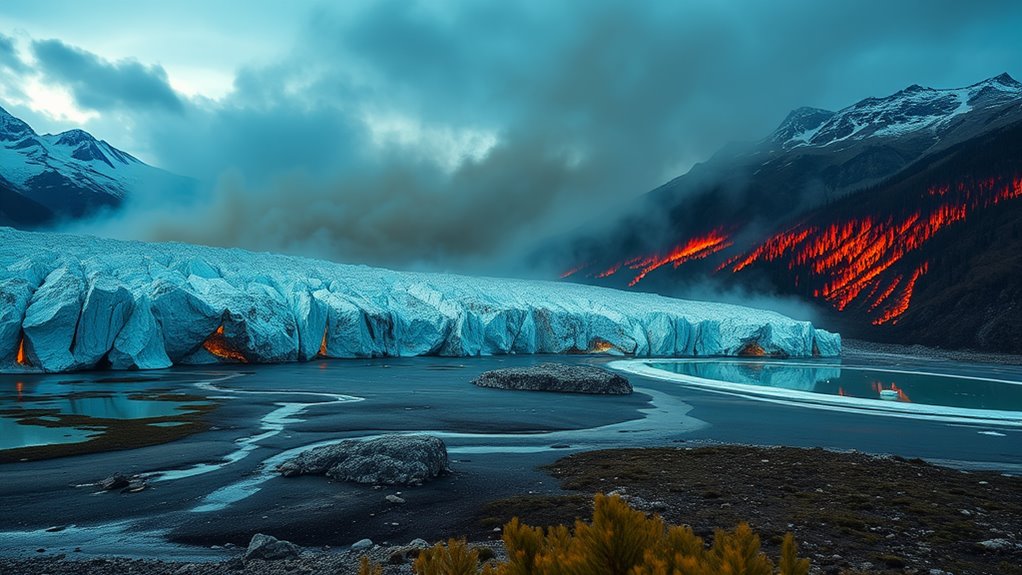
While the universe's fate may seem distant, the imminent threats posed by climate change and global risks are pressing concerns for humanity. Extreme weather events are the top risk likely to trigger a global crisis in 2024, exacerbated by the warming phase of the El Niño-Southern Oscillation. With a 93% chance that one of the years from 2022 to 2026 will be the warmest on record, you're witnessing unprecedented temperature rises. This trend is set to push average global temperatures over 1.5°C, jeopardizing ecosystems and human livelihoods.
Biodiversity loss and ecosystem collapse loom as critical threats, especially as interconnected environmental risks escalate. These risks can trigger socio-environmental crises, leading to significant challenges for climate-vulnerable countries, exacerbating issues like involuntary migration and health crises. In light of the projected population growth in Africa, the urgency to implement effective climate resilience strategies has never been greater. You must recognize the importance of addressing ecological tipping points. Ignoring these can lead to irreversible changes in Earth systems, affecting future generations.
The adaptive capacity of societies is being stretched, and without swift action toward emissions reduction and a clean shift, the repercussions could be dire. In this context, enhancing decision-making tools that consider both climate change and ecological tipping points is essential for effective risk management. You need to stay informed and engaged, as the choices made today will shape the world you live in tomorrow.
Upcoming Astronomical Events

Exciting astronomical events are on the horizon, and you won't want to miss them. On June 26, 2029, prepare for the largest total lunar eclipse of the 21st century, boasting an impressive umbral eclipse magnitude of 1.84362.
Just a year later, on June 1, 2030, an annular solar eclipse will be visible in Northern Africa, the Balkans, and Russia, followed by another total solar eclipse on November 25, 2030, seen in Southern Africa and Australia.
The excitement doesn't stop there. On April 13, 2029, near-Earth asteroid (99942) Apophis will pass just 31,200 km above our planet, a close encounter to watch!
Later, on May 21, 2031, another annular solar eclipse will take place, and on November 14, 2031, you can witness a hybrid solar eclipse.
Don't forget about the comets and meteor showers! Mark May 20, 2031, for the perihelion of Comet 55P/Tempel-Tuttle, which is the source of the November Leonids.
An outburst is expected on November 17, 2033, potentially delivering an astonishing 35-400 meteors per hour.
With planetary transits also on the agenda, such as the transit of Venus from Uranus in 2031, the sky will be bustling with activity.
Keep your eyes on the heavens—there's so much to look forward to!
Social Conflicts and Instability

Recent global trends reveal an alarming increase in social conflicts and instability, with 56 active conflicts involving 92 nations—the highest number since World War II. You might feel the weight of this reality, especially when reflecting on the staggering 162,000 conflict-related deaths in 2023, with Ukraine and Gaza leading the toll.
As global militarization escalates, it's essential to recognize how these conflicts impact your life and the world around you.
Here are some key points to reflect on about social unrest and instability:
- Increased Violence: North America has seen a significant rise in violent crime and fear, which deteriorates the sense of safety.
- Economic Consequences: The economic impact of violence surged to $19.1 trillion, translating to 13.5% of global GDP.
- Displacement Crisis: Over 110 million people are now either refugees or internally displaced due to ongoing conflicts.
- Political Instability: Political unrest has surged in 59 countries, while only 22 experienced improvements.
- Food Insecurity: Conflicts drive hunger, with 70% of the world's hungry living in war-torn regions.
You're living in a time marked by instability, where the consequences of militarization and conflict affect everyone.
The need for awareness and proactive engagement has never been more critical as societies grapple with these challenges. Understanding the underlying issues can help you navigate this turbulent landscape.
Cultural Beliefs and Philosophies
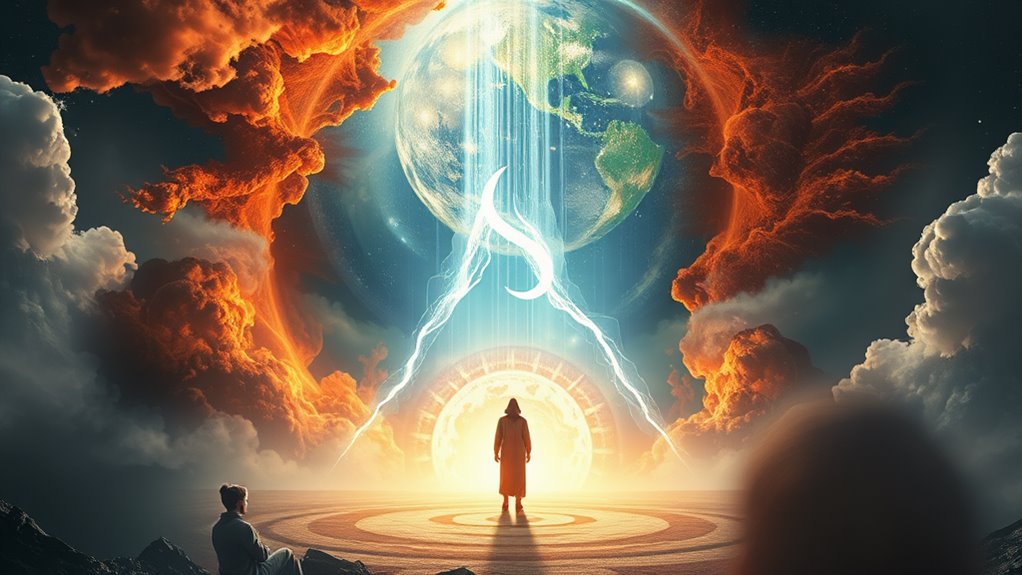
Cultural beliefs and philosophies shape how you perceive the end of the world, offering a diverse array of interpretations across different societies. In Abrahamic religions, for instance, cultural narratives detail events leading to the "end of days." Judaism anticipates the Messiah's arrival and the resurrection of the righteous, while Christianity envisions a tribulation period before Christ's second coming, culminating in a new earth.
Islam also emphasizes a Day of Judgment, underscoring individual moral accountability and the ultimate triumph of good over evil.
In Dharmic religions, the end is seen cyclically. Hinduism speaks of Kalki ending the Kali Yuga, heralding regeneration and a return to a golden age. Buddhism predicts the Maitreya's arrival to restore forgotten teachings amidst decay.
Zoroastrianism introduces Frashokereti, envisioning a final renovation where good prevails and unity with Ahura Mazda is restored.
The philosophical implications of these beliefs extend beyond mere predictions. They influence how societies understand time, morality, and human responsibility. Many cultures have shifted from circular to linear concepts of time, intensifying the urgency surrounding potential apocalyptic events.
This has driven technological innovations, reflecting a desire to address existential threats.
Ultimately, your beliefs shape not just your view of the end but also how you engage with the world today. Recognizing these cultural narratives can offer insight into humanity's collective anxieties and hopes for the future, enriching your understanding of life's profound mysteries.
Frequently Asked Questions
Are There Any Historical Predictions That Came True About the End of the World?
You might think apocalyptic literature is full of prophetic visions that always come true, but history tells a different story.
Many predictions, like those from Luther and Whisenant, fizzled out without a trace. However, some events, like the destruction of Jerusalem in A.D. 70, lined up with biblical prophecies.
While these fulfillments exist, they don't guarantee future predictions will play out as anticipated.
Keep questioning, because truth often lies in the details!
How Do Different Cultures View the Concept of the End of the World?
Different cultures view the end of the world through unique lenses, shaped by apocalyptic myths and religious narratives.
You'll find that existential fears often drive these beliefs, linking to environmental concerns and societal collapse.
Prophetic texts highlight cosmic events, giving meaning to impending doom.
Cultural symbolism enriches these narratives, allowing communities to interpret their experiences and histories.
What Role Does Technology Play in Shaping Future Predictions?
Technology plays an essential role in shaping future predictions.
You'll see artificial intelligence enhancing data analysis and predictive modeling, leading to more accurate forecasts in areas like climate change.
Scientific advancements empower you to understand complex systems better, enabling timely interventions.
The societal impact is profound; as technology evolves, it influences decision-making, resource management, and public policies, ultimately driving a more informed and adaptive society in the face of future challenges.
Can We Quantify the Likelihood of Various End Scenarios?
Think of likelihood assessment as a compass guiding you through a dense forest of existential risks.
You can quantify various end scenarios using predictive models that apply scientific approaches. By breaking down risks like climate change or runaway AI, you can evaluate their potential societal impacts.
Though predicting the future is tricky, these methodologies help you navigate the uncertainties, shedding light on the probabilities of catastrophic events that could reshape our civilization.
How Do Personal Beliefs Influence Perceptions of the End Times?
Your personal beliefs shape how you view apocalyptic themes and religious interpretations. They can amplify existential fears, influencing your emotional responses.
Cultural narratives surrounding the end times inform your understanding, making you more susceptible to psychological impacts.
When analyzing prophecies, you might find that your beliefs color your interpretations.
Ultimately, how you perceive the end times reflects your values and experiences, guiding your reactions to potential future scenarios.
